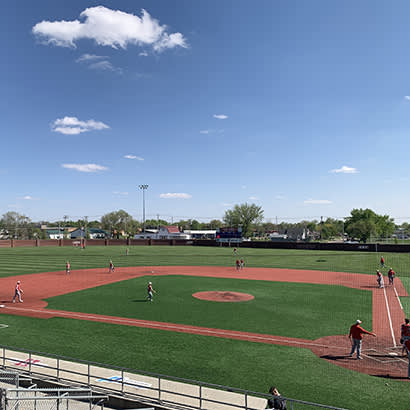
For an enhanced digital experience, read this story in the ezine.
The issue with the athletic infrastructure in Hastings, Nebraska, has never been one of quality. Parks Maintenance Superintendent Terry Brown and his full-time staff of 11 do their job so well that, each summer, local American Legion baseball and collegiate summer league schedulers vie with regional tournament directors for access to the city’s baseball and softball facilities. In 2019, Duncan Field, the premier baseball diamond in Hastings, played host to the Mid-South American Legion Regional Championship. That event returned this past summer.
Neither Brown nor his colleagues feel nickel-and-dimed when it comes to funding and staffing. With two local high schools and Hastings College making such dedicated use of these facilities — including the eight-diamond, 60-acre softball property, which includes four soccer fields — the city of Hastings recognizes these as the extraordinary community assets they are.
The problem is keeping the grass alive.
“Starting in March and going to when our baseball season ends in August, there just isn’t enough time to repair the grass. Those fields just get pounded,” Brown explains. “And once baseball season ends, we go straight into football season, which goes to November, when the growing season is over.
“Everything we do in terms of turf care has to be done during a four-hour window each morning, which we heavily schedule — every day. But there just isn’t enough time to cover all that acreage. So, we do what we can on the fly.”
Brown is committed to a three-pronged plan that park and athletic field superintendents across the country — in all the various climatic zones — will find interesting, both for its simplicity and flexibility.
Prong 1: Cultural Practices
The soil in Hastings is, according to Brown, “pretty good.” Even so, those four hours each morning are steadfastly devoted to systematic aerification and top-dressing. The mowing? That’s the easy part, because there is no immediate disruption following that ongoing exercise.
“There’s a master spreadsheet that keeps track of all the aerification work we do,” he says. “When we’ve touched every field on the sheet, we just go back to the beginning and start again. We fertilize on that schedule, too, more or less. The NPK [nitrogen, phosphorus and potassium] we use at pretty high levels, mainly slow-release nitrogen. This is basic stuff but it’s a must on account of our traffic.”
In all, Brown looks after some 400 acres of property, including 25 parks and a lake. Hastings, a city of 25,000 located in South/Central Nebraska, 40 miles from the Kansas border, doesn’t skimp on staff. Come summer, it adds 20 to 30 seasonal workers — the bulk of whom are deployed on the baseball and softball facilities.
“We are heavy into parks in the city of Hastings,” Brown says, “but we don’t aerify there with the same regularity. It’s the sports fields that get pounded and if we don’t aerify, the rootzone will get compacted.”
Prong 2: Water Management
The most disruptive thing any athletic field manager does, short of reconstruction or resodding, is irrigation. Brown and the Hastings crew make use of those four morning hours as best they can. They irrigate after hours. But there is not enough time in between all these games and practices to get all those acres of turf the water they need.
“You can only water so much, but the Moisture Manager helps me get through those hot spells, those 100-degree days,” Brown says.
LESCO Moisture Manager’s technology, called Hydretain, is a hygroscopic humectant, the sort of ingredient commonly used to retain moisture in things like toothpaste, gum and cosmetic products. Applied in liquid form, as part of a spray regimen, the product coats soil particles and plant roots. In doing so, it attracts to those roots moisture already present in the soil profile — moisture in the form of water vapor or humidity that would otherwise be lost to evaporation.
“I used to water the fields every day, but now it’s every other day. With our scheduling issues, that makes a huge difference.”
Hastings has not experienced any water rationing. Not yet anyway. But Brown recognizes that this technology allows him to use far less water at his athletic properties — something he reckons is relevant to all those park superintendents where water is being rationed or has become inordinately expensive.
Prong 3: Cultivar Choices
When Brown arrived in Hastings 26 years ago, all the city-managed fields were ryegrass. Slowly but surely, through diligent overseeding, he has sifted in more durable varieties of bluegrass. Without that long-term effort, Brown doesn’t think his facilities would be able to handle all the wear and tear.
“Seems like I’m always going with the darker blues. I started with Midnight Eclipse, but I switched to Appalachian and Rock Star. I’ve worked a lot of bluegrass in there basically by constantly overseeding — three to four times a year. But…I really like the color, as well. That won’t last without the aerification, or the Moisture Manager, all the best practices we try to follow. But the bluegrass really is nice looking. And it can take the pounding.”
Duncan Field takes the biggest pounding. It’s also the jewel in the crown, so far as Brown is concerned.
“It’s a legitimate major league baseball diamond, 405 [feet] to center and 380 [feet] down each line. And it’s got a great history unto itself: Yogi Berra played here! We have a board that lists everyone who ever hit a home run here. The aluminum bats have skewed that just a bit. But still,” Brown says.
“It’s pretty mindboggling that so many tournaments have been held here and continue to be held here — at the softball complex, too. We’re a little out of the way…but the community is proud of that history, and we do all we can to keep it going.”
Hal Phillips is Managing Director of Mandarin Media.

